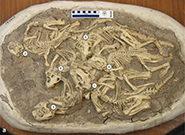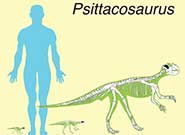Psittacosaurus, the ‘parrot dinosaur’ is known from more than 1000 specimens from the Cretaceous, 100 million years ago, of China and other parts of east Asia. As part of his PhD thesis at the University of Bristol, Qi Zhao, now on the staff of the Institute for Vertebrate Paleontology in Beijing, carried out the intricate study on bones of babies, juveniles and adults.
Dr Zhao said: "Some of the bones from baby Psittacosaurus were only a few millimetres across, so I had to handle them extremely carefully to be able to make useful bone sections. I also had to be sure to cause as little damage to these valuable specimens as possible."
With special permission from the Beijing Institute, Zhao sectioned two arm and two leg bones from 16 individual dinosaurs, ranging in age from less than one year to 10 years old, or fully-grown. He did the intricate sectioning work in a special palaeohistology laboratory in Bonn, Germany,
The one-year-olds had long arms and short legs, and scuttled about on all fours soon after hatching. The bone sections showed that the arm bones were growing fastest when the animals were ages one to three years. Then, from four to six years, arm growth slowed down, and the leg bones showed a massive growth spurt, meaning they ended up twice as long as the arms, necessary for an animal that stood up on its hind legs as an adult.
Professor Xing Xu of the Beijing Institute, one of Dr Zhao’s thesis supervisors, said: "This remarkable study, the first of its kind, shows how much information is locked in the bones of dinosaurs. We are delighted the study worked so well, and see many ways to use the new methods to understand even more about the astonishing lives of the dinosaurs."
Professor Mike Benton of the University of Bristol, Dr Zhao’s other PhD supervisor, said: "These kinds of studies can also throw light on the evolution of a dinosaur like Psittacosaurus. Having four-legged babies and juveniles suggests that at some time in their ancestry, both juveniles and adults were also four-legged, and Psittacosaurus and dinosaurs in general became secondarily bipedal."
The paper is published today in Nature Communications.
Paper
'Histology and postural change during the growth of the ceratopsian dinosaur Psittacosaurus lujiatunensis' by Zhao, Q., Benton, M.J., Sullivan, C., Sander, P.M., and Xu, X. in Nature Communications

